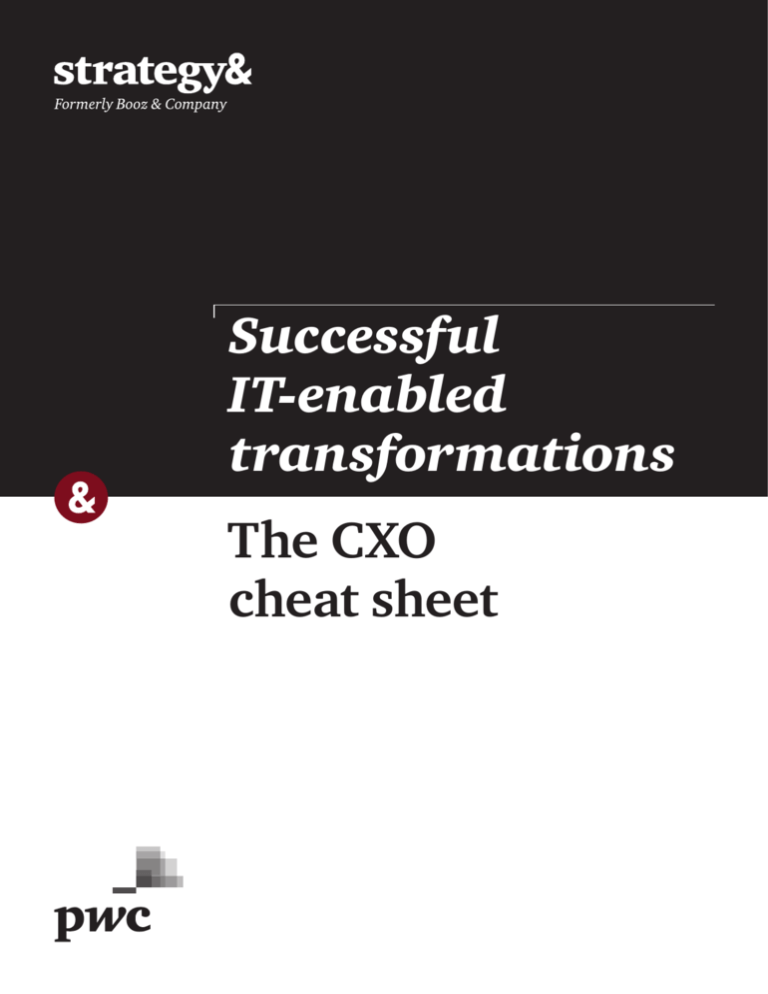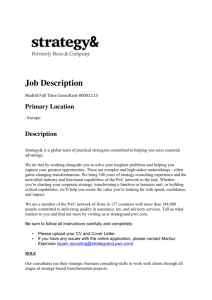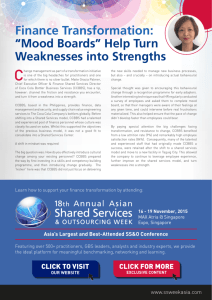
Successful
IT-enabled
transformations
The CXO
cheat sheet
Contacts
Beijing
Houston
New York
Sydney
Sarah Butler
Partner
+86-21-2327-9800
sarah.butler
@strategyand.pwc.com
Henning Hagen
Partner
+1-713-650-4165
henning.hagen
@strategyand.pwc.com
Christopher Vollmer
Partner
+1-212-551-6794
christopher.vollmer
@strategyand.pwc.com
Steven Hall
Principal
+61-2-9321-2835
steven.hall
@strategyand.pwc.com
Dubai
Kuala Lumpur
David Tusa
Partner
+971-4-390-0583
david.tusa
@strategyand.pwc.com
David Hovenden
Partner
+60-3-2095-3188
david.hovenden
@strategyand.pwc.com
Dr. Florian Gröne
Principal
+1-212-551-6458
florian.groene
@strategyand.pwc.com
Nick Kotwal
Principal
+61-2-9321-1985
nick.kotwal
@strategyand.pwc.com
Paris
Tokyo
Düsseldorf/Stockholm
London
Roman Friedrich
Partner
+49-211-3890-165
roman.friedrich
@strategyand.pwc.com
Richard Bhanap
Partner
+44-20-7393-3519
richard.bhanap
@strategyand.pwc.com
Pierre Péladeau
Partner
+33-1-44-34-3074
pierre.peladeau
@strategyand.pwc.com
Toshiya Imai
Partner
+81-3-6757-8600
toshiya.imai
@strategyand.pwc.com
Frankfurt
Los Angeles
Dr. Germar Schröder
Principal
+49-69-97167-426
germar.schroeder
@strategyand.pwc.com
Dan Priest
Senior Executive Advisor
+1-424-294-3800
dan.priest
@strategyand.pwc.com
São Paulo
Ivan de Souza
Senior Partner
+55-11-5501-6368
ivan.desouza
@strategyand.pwc.com
Frankfurt/Dubai
Olaf Acker
Partner
+49-69-97167-453
olaf.acker
@strategyand.pwc.com
2
Strategy&
About the authors
David Hovenden is a partner with Strategy& based in Kuala Lumpur.
He leads the firm’s Southeast Asian business and the global markets
digital business and technology practice.
Nick Kotwal is a principal with Strategy& based in Sydney. A co-leader
of the firm’s digital business and technology practice, he has expertise
in driving efficiency and productivity across large-scale business
transformations in Australia, New Zealand, and Southeast Asia
(ANZSEA).
Bertrand Friot is a senior associate in Strategy&’s digital business and
technology practice based in Melbourne. He has deep expertise in IT
strategy and architecture across large, complex enterprise
transformations in the ANZSEA region.
Nicolas Mialaret is an associate in Strategy&’s digital business and
technology practice based in Sydney. He focuses on large-scale
enterprise transformations within the media and telecommunications
industries in the ANZSEA region.
This report was originally published by Booz & Company in 2013.
Strategy&
3
Executive summary
Large-scale IT transformations are notoriously prone to failure. In
our view, this is because most companies do not consider the problem
holistically. As a result, program management is not clearly focused,
planning suffers, and execution is weak. A truly overarching view of a
major IT-enabled transformation must be built on a solid foundation of
four key elements.
First, companies must align the transformation with overall corporate
strategic and business goals, and all stakeholders must buy into the
future vision. Then, they must settle on the necessary transformation
capabilities, and fill any gaps in current capabilities. Third, the
transformation team must work to create an agile interim architecture
that can see the company successfully through the transformation,
maintaining business continuity while enabling the planned
changes. Finally, successful execution will require the creation of a
transformation operation model and appropriate progress monitoring
and governance procedures for guiding the program to completion.
4
Strategy&
The problem and the solution
Business and IT professionals at every large company know all too well
just how difficult it can be to carry out large-scale, IT-enabled business
transformations. These projects are massively complex and highly
disruptive to long-standing business processes and their end-users, and
can span years and cost hundreds of millions of dollars. Why such
projects fail is presumably well understood: lack of user involvement,
weak support from top management, unclear business objectives — the
list is long. So if both the degree of difficulty and the causes of failure
are so well known, why do these efforts keep failing?
In our experience advising on and supporting such transformations at
a variety of large companies, we have observed that the problems
aren’t simply a matter of poor planning, weak execution, or unfocused
management. Instead, they typically lie in a company’s unwillingness
or inability to take a realistic, overarching view of the transformation,
and of the four key elements needed to carry the project through to
completion (see Exhibit 1, next page).
• Strategic alignment: Companies embarking on a major
transformation must explicitly link a transformation’s desired
business outcomes with the strategic objectives and goals of the
company.
• Transformation capability: For large-scale transformations to
succeed, the necessary capabilities must be in place, including
effective governance mechanisms, program delivery expertise,
vendor management and sourcing, and enterprise architecture
and design.
• Agile architecture: An IT architecture must be resilient enough to
allow the organization to react and respond to ongoing changes
in the market while executing the transformation program.
• Execution excellence: Critical execution components — including a
transformation operating model and the underlying operational and
risk mechanisms — must be in place and working together if the
Strategy&
5
Exhibit 1
Four mutually reinforcing elements of IT-enabled transformations
1. Strategic
alignment
2. Transformation
capability
4. Execution
excellence
3. Agile
architecture
Key questions
1. Strategic
alignment
Alignment of the outcomes pursued
by the transformation with the strategic
objectives and goals of the company
Is the proposed transformation the most
effective way to achieve the company’s
strategic objectives?
2. Transformation
capability
Ensuring that the company has the
necessary capabilities in place to
embark on the transformation
Do we have the right capabilities to deliver
the desired business outcomes?
3. Agile
architecture
Developing a flexible and agile
architecture that adapts to the needs
of a dynamic multiyear transformation
Is the architecture capable of aligning to a
moving target state while maintaining
momentum on the program?
4. Execution
excellence
Excellence in applying the capabilities
while executing the transformation
Can we execute the transformation in a
way that delivers outcomes on budget
and on time while minimizing risk?
Source: Strategy&
6
Strategy&
program is to be delivered on time, within budget, and at the
expected level of quality.
These four elements must not be seen as steps in a process; instead, they
must interact with and inform one another, leading to a smoother
transformation process and repeatable transformation capabilities for
the future.
A large Australian financial-services company adopted this strategy
when it acquired a competitor and merged the two entities into a single
operating model. To ensure that the transformation program succeeded,
the company identified 12 business outcomes involving customers,
advisers, shareholders, and staff that defined the target operating
model. Business outcomes were broken down into their constituent
requirements, which were prioritized and bundled into a road map of
initiatives. In addition, the company assessed its transformational
maturity and competency in enterprise portfolio management, value
management, and governance, all of which would be needed to deliver
the program while maintaining strategic alignment. The result was a
thoroughly integrated program with an empowered team driving to a
common outcome.
Strategy&
Four key
elements must
interact with
and inform one
another, leading
to a smooth
transformation
process and
repeatable
capabilities.
7
Strategic alignment
Every company is looking for a strategic advantage in an increasingly
competitive business environment. Gaining that advantage involves
determining a deliberate value proposition, or “way to play,” given the
opportunities available in the company’s market, and then developing the
system of capabilities and the product and service portfolio best suited
to that way to play. IT’s task is to enable the transformation required for
companies to achieve their strategic vision. To do that, IT must understand
the vision, and then develop a clear and agreed-on proposition and
road map for achieving it (see “Digitizing the Business,” page 11).
Accomplishing this requires several foundational steps:
• Focus on the prize. IT must focus on the essential capabilities that enable
the company’s way to play in the market, and make sure the business
and enterprise architecture is tightly linked to those capabilities.
Building business cases supporting why and how IT will strengthen
those capabilities will establish the credibility needed to proceed.
• Establish stakeholder buy-in during the planning stage. A clearly
defined end-state vision encourages top management and key
stakeholders to support the transformation and its goals. Showcasing
tangible improvements in business processes and customer
experience early on builds internal support. Identifying influential
“enthusiasts” to support the vision or take on leadership roles in the
transformation can clear a path to approval.
IT must
understand
the company’s
strategic vision,
and then
develop a clear
proposition and
road map for
achieving it.
• Stay aligned to the vision. Make sure that the transformation road
map is set up to produce clear benefits aligned to strategic priorities
and to leverage the organization’s essential capabilities. Project
spending should be weighted toward those priorities and benefits,
while less critical areas are tightly managed. This will demonstrate
the project’s value to key stakeholders and build confidence
throughout the company.
The importance of alignment was made clear in the case of a large
Southeast Asian bank that had developed a strategy for becoming a
8
Strategy&
leader throughout the region by 2015. The bank embarked on a largescale transformation program to develop multichannel sales and
service capabilities, build integrated customer analytics to improve
performance and drive revenue, and increase flexibility through agile
product manufacturing. It began by developing a tailored program
strategy and an operating model aligned to its primary capabilities
systems (see Exhibit 2). This was achieved by designing a modular
Exhibit 2
Alignment of bank’s strategic intent and program outcomes
Bank
vision & mission
Wholesale banking
strategic considerations
Insurance
strategic considerations
Strategic intents
Strategic intents
Strategic intents
Strategic imperatives
Strategic imperatives
Strategic imperatives
Capabilities
Capabilities
Capabilities
Financial-services
strategic considerations
Enterprise architecture
Enterprise architecture
Target business architecture
Design and
architecture
principles
Target application architecture
Design
architecture
practice
Target information architecture
Target infrastructure architecture
IT transformation operating model, programs of work, and road map
Source: Strategy&
Strategy&
9
enterprise architecture that enhanced its core capabilities, deprioritized
low-value initiatives, and sourced new capabilities in selected areas.
The result was a coherent multiyear transformation road map that
enabled the bank to make a quantum leap compared to its regional
competitors.
10
Strategy&
Digitizing the business
What does tight alignment between
overall strategy and transformation
goals look like? A large vehicle-leasing
company recently decided to pursue
a mass-customization strategy that
would require revamping the entire
leasing value chain by streamlining
and automating its processes for
lease management, pricing, contract
changes, and lease termination.
The company embarked on a large
transformation project involving the
replacement of its fragmented IT legacy
systems — there were more than 100 —
with an industry-specific ERP solution.
The expected cost: US$100 million.
During the business operations
reengineering phase, the company
realized that a specific product category
Strategy&
required highly distinctive business
processes. Migrating the category over
to the new platform would require
costly customization and extension of
the data needed to support it. Following
a detailed cost-benefit analysis that
included executive-level stakeholders,
the company decided that it would
be better to simply retire the product
category, given the company’s new
strategy.
By eliminating excess technical
complexity, the program delivered
a standardized solution that was easier
to support and manage. The result:
a more profitable and agile system
of business processes that adhered
more closely to the company’s
strategic vision.
11
Transformation capability
Once a company settles on a way to play and the essential capabilities
needed to support it, it must ensure that it has the right set of drivers
and capabilities in place to carry out the transformation.
The drivers, which can vary from company to company, demand
careful consideration, as they will determine the ultimate success of the
transformation. To clarify its readiness to embark on the transformation
journey, the company must assess the current level of maturity for each
driver, and identify gaps between its current state and what is required
to carry out the transformation (see Exhibit 3, next page). Any
capabilities that are perceived as “lacking” or “ad hoc” must be raised
to the “competitive” level, either by strengthening them internally or
by sourcing them externally. Worth noting — in our experience, an
organization does not need to excel at every driver.
12
Strategy&
Exhibit 3
Sample transformation drivers and capability/maturity assessment tool
Transformation drivers & capabilities
Stewardship
Program
management &
governance
Strategic supply and demand
Program management and program office
Project management and project office
Performance
management
Economics and value management
Integrated business case enablement
Project business case
Capacity optimization
Transition to support
Transition to operations
Transition
management
Capability building
Vision &
strategy
Clear strategy (“true north”)
Capability sequencing
Project scope
Design &
development
Business design and building
Integrated capability design and building
Solution design and building
Operational testing of capabilities
Technical
readiness
Technical testing
Ownership building
Stakeholder
management
Change
management
Aligned leadership team (“one voice”)
Aligned work stream leads
Aligned project stakeholders
Changed organization and stakeholder community
Changed and up-skilled users—staff and customers
Changed organization and stakeholder community
Organizational readiness
Communities of practice and excellence
Business
readiness
Lacking
Ad hoc
Competitive
Best-in-class
Differentiated
Little to no
capability
internally, across
four dimensions
· People
· Processes
· Tools
· KPIs
Capability exists
with known gaps;
for example:
· Skill gaps in
delivery teams
· Processes not
documented
end-to-end
· Tools exist but
not embedded
in practice
· KPIs not
defined
Capability exists
and can be
relied on:
· No internal
skill gaps
· Processes are
in place and
documented
· Necessary
tools are in
place and
embedded
· Performance
drivers are
defined and
tracked
Capability is
strategic to the
firm’s success
Firm recognized
by market, clients,
and rivals for its
capability
Strategy&
Ability to attract
top talent
The capability
framework is
linked to the
enterprise
architecture
Project focus 0–2 years
Program focus 1–3 years
Portfolio focus 3–5 years
The firm leverages
its teams, processes,
and tools to operate
in a differentiated way
giving it a competitive
advantage
The tool kit is
integrated
end-to-end
Performance drivers
are tracked and
continuous plans
are in place
Source: Strategy&
13
Agile architecture
Large-scale transformations are invariably disruptive and are likely to
affect how the business carries out its day-to-day operations. The
transformation program must be designed with the flexibility to
accommodate current business activities as well as inevitable changes.
To keep everything running smoothly, the company needs to put in
place an agile architecture, with backstops and checkpoints to ensure
that it can overcome problems and deal with tactical issues effectively.
An agile architecture has three defining characteristics:
• It provides flexibility and agility. An agile architecture gives the
business the ability to make changes in the transformation program
and to meet interim business needs even as the new enterprise
architecture is being developed.
• It maintains momentum. An agile architecture guides companies
in making sure the program maintains momentum, preserves
alignment with overall strategic imperatives as it progresses,
and enables the program to deliver necessary new functions.
• It is aligned to the target end state: An agile architecture lets program
managers adjust for changes in the program’s deliverables throughout
the life of the program, while keeping a firm eye on its goals.
Creating an agile architecture can be the purview of the company’s
design authority, which is responsible for the high-level design of the
IT transformation and the ensuing robust enterprise architecture to
support it. The design authority also oversees the systems integrator’s
overall plans, as well as the functional and technical details. It makes
sure that the functional and technical aspects of the program remain in
alignment with one another over the course of the program (see Exhibit
4, next page).
14
Strategy&
Exhibit 4
The core functions of the design authority
Design authority functions
Change and
configuration
management
1
5
Enterprise
architecture
stewardship
Technology
strategy and
advocacy
2
Technical
assurance
Artifacts/
baseline
6
4
Testing and
delivery
assurance
3
Functional
and business
assurance
1 Enterprise architecture stewardship
Oversee enterprise architecture, including development of conceptual and
logical architectures
Refine and update all architectures, including linkages, design principles,
and standards
2 Technical assurance
Provide assurance of physical architecture developed by systems integrator
Facilitate interaction among the systems integrator and internal stakeholders to
mitigate design risk and ensure all key areas are covered in architecture
3 Functional and business assurance
Provide assurance of proposed changes to the designed processes
Ensure that the proposed solution design will meet the day-to-day business
requirements under “real operating environment” and against functional
performance specifications
4 Testing and delivery assurance
continued
Review
and approve testing approach, scenarios, and results by testing
components, end-to-end integration, and user acceptance
Provide advice to accept delivery and introduction into service
Strategy&
5 Technology strategy and advocacy
Research emerging technologies and trends in support of best practices in
15
Ensure that the proposed solution design will meet the day-to-day business
requirements under “real operating environment” and against functional
performance specifications
4 Testing and delivery assurance
Review and approve testing approach, scenarios, and results by testing
components, end-to-end integration, and user acceptance
Provide advice to accept delivery and introduction into service
5 Technology strategy and advocacy
Research emerging technologies and trends in support of best practices in
industry and business domain
Perform advocacy, including communication, awareness, and engagement
6 Change and configuration management
Manage all proposed changes to system scope, budget, or time line, undertaking
impact assessments of all proposed changes
16
Source: Strategy& analysis
Strategy&
Execution excellence
The key to a successful IT-enabled transformation lies in its execution.
No matter how thoroughly the strategy and the design have been
thought through, if the plan isn’t put into practice carefully and
thoroughly, the effort will fail. As such, much depends on the
transformation operating model, which guides the program; sets its
structure, information flows, decision rights, and accountability at every
level; and ensures that the proper levels of control and risk management
can be monitored throughout the program’s life.
To ensure success, the operating model should also consider the
following components:
Smart PMO: A key part of the operating plan, and central to the
transformation’s success, is the “smart” program management office
(PMO), which combines the activities of the traditional PMO with the
analytical insight needed to keep key stakeholders apprised of progress.
The typical PMO oversees and reviews the many projects going on
simultaneously, responds to problems, and advises top management on
progress. Serving as the locus of communication, the smart PMO can
also provide senior management with insight into budgets, costs, and
progress; assess and prioritize future initiatives; and propose options to
manage delivery interdependencies at a program level.
Stage-gate approval process: Stage gates provide deliberate checkpoints
for assessing critical aspects of the transformation, along with an
assessment of leading and lagging indicators. They help in ascertaining
the progress of the program’s various initiatives and phases and provide
senior management with accurate information on whether desired
business outcomes are being achieved. The results of stage-gate reviews
need not come as a surprise if the process includes ongoing monitoring
and closer investigation of problems as they arise.
Change control board: Every large-scale transformation project will
require changes at some point, for any number of reasons, including
scope, scale, budget, and resources. Change control boards manage this
Strategy&
17
process, reviewing and approving change requests using consistent
criteria; ensuring alignment of proposed changes with objectives;
assessing impact on costs, schedules, and resources; and
communicating the results to all stakeholders.
Visual management hub: Central to the operating rhythm of a major
transformation is the visual management hub, a room that is dedicated
to the transformation’s information flows. The PMO is responsible for
ensuring that the hub is kept up-to-date by project teams, in order to
effectively share information among all stakeholders and facilitate
decision making at the level of the overall transformation and its
various initiatives. The hub should include information related to dayto-day deliverables as well as program-level snapshots of overall
progress. Because of the sheer quantity of information that the hub
tracks as the transformation moves forward, information must be
presented graphically, and in such a way that stakeholders can home in
on problems quickly.
Twelve-month look ahead: Many of the assessment activities involved in
the management of large transformation programs tend to look
backward at what has already been accomplished. Just as important,
however, is to set up a process for looking forward. The 12-month look
ahead provides stakeholders with a mechanism to view the program
through the windshield — with a strategic view of future milestones
and the critical path to reach them — rather than through the rearview
mirror. Reviewed regularly by the steering committee and featured
prominently in the visual management hub, the look ahead should
provide a detailed rolling view of the upcoming four weeks and a highlevel rolling view of key milestones over the coming 12 months.
18
Strategy&
Conclusion
Large-scale transformation programs that realign companies to new
strategic imperatives are enormously complicated, risky, and highly
prone to failure. Four interlocking and mutually reinforcing elements
will set up the transformation for success: aligning the transformation’s
expected outcomes to the corporate strategy; putting transformation
capabilities in place early, before moving into execution; designing an
agile IT architecture that flexes in response to unforeseen business or
program circumstances; and establishing a transformation operating
model that is hard-nosed and approaches execution systematically.
Companies that get these critical elements right can help ensure that
their major transformations deliver the business benefits their
stakeholders are looking for.
Strategy&
19
Strategy& is a global team
of practical strategists
committed to helping you
seize essential advantage.
We do that by working
alongside you to solve your
toughest problems and
helping you capture your
greatest opportunities.
These are complex and
high-stakes undertakings
— often game-changing
transformations. We bring
100 years of strategy
consulting experience
and the unrivaled industry
and functional capabilities
of the PwC network to the
task. Whether you’re
charting your corporate
strategy, transforming a
function or business unit, or
building critical capabilities,
we’ll help you create the
value you’re looking for
with speed, confidence,
and impact.
We are a member of the
PwC network of firms in
157 countries with more
than 184,000 people
committed to delivering
quality in assurance, tax,
and advisory services. Tell us
what matters to you and find
out more by visiting us at
strategyand.pwc.com.
This report was originally published by Booz & Company in 2013.
www.strategyand.pwc.com
© 2013 PwC. All rights reserved. PwC refers to the PwC network and/or one or more of its member firms, each of which is a separate legal entity. Please see www.pwc.com/structure for further
details. Disclaimer: This content is for general information purposes only, and should not be used as a substitute for consultation with professional advisors.









